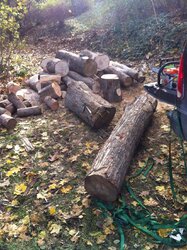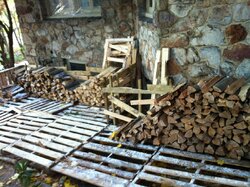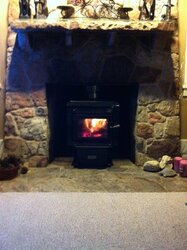I'm not sure if this is going to give everyone the gratification you all deserve, but I wanted to let you all know that your advice was indispensable. You helped me go from completely ignorant (and probably a little dangerous) to well informed, and most importantly a new wood stove user.
Here's my effort at repaying you all with a narrative of the instal:
I pulled the chimney-topper off; not going to lie, it was really heavy, both physically as well as figuratively, as this was the "point-of-no-return" step for my girlfriend. 6 stone blocks, each of which were easily >70lbs. Some of the posts holding them up had loosened over the years making it a bit dicey, but worked it all out without any problems.
After I got us both (girlfriend was a little skeptical of this whole endeavor but played along nice) fully committed, I pulled the NG line on the log fireplace. Not a big deal at all.
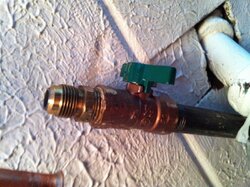
Capped the line, and done. I now have the cap as well as the cut-off valve before any NG can get out.
Once I pulled the log set, i found that the NG line to the fireplace ran through an open brick that had been pulled out. More interesting, was that below the fireplace was a open space all the way down to the foundation. I never mentioned that the chimney extends into the basement and is closed, but I wasn't expecting the 10' deep open hole. I kept imagining the cat falling in which would have been an interesting time

. So I made sure to keep it blocked off during the install.
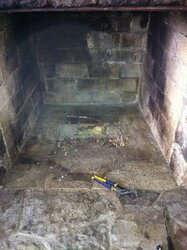
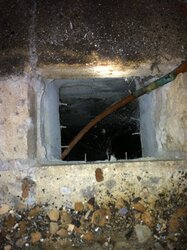
I pushed the copper NG (now unattached) down below the stone (about 14"). Pulling it out would have been a PIA.
Next, I had a chimney sweep come in and inspect the chimney. I wanted to be sure that there wasn't anything interesting going on that I needed to be worried about. Cost me $75, but I would prefer to error on the side of caution. Told him my plans and got a big green light. He also said if I was to pay him to do what I was planning, it would cost ~$900!?!?!?!
Next Chimney Liner installation. This part was no fun. Lots of work and sweat
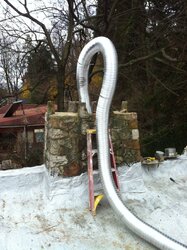
The chimney is just about 9 inches at the widest, but only 7" and change at the smallest (rectangular), so it was a serious effort to get it down. I was pushing from the top. girlfriend was pulling hard at the bottom (i wrapped a 30' rope with a clove hitch to the bottom of the liner and duct-tapped 3 loops of pull). Took about 4 hours of effort, but got it set.
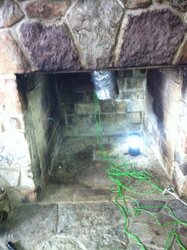
After that, I had to do a little customizing of the cap to fit the stones on the chimney. Angle-grinders have lots of uses

Did the finish work with tin-snips.
Bought some Roxul insulation to fill the chimney at the top and down where I had built the block-off plate.
Sadly, had to buy a large bag of 16 batts, when I only needed 3, but it was the smallest amount sold.
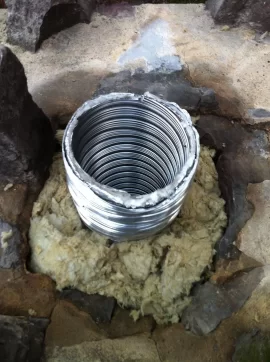
(this is the top of the chimney)
Not sure if i did it right here, but I used chimney cement to fix the metal cap plate to the top of the chimney.
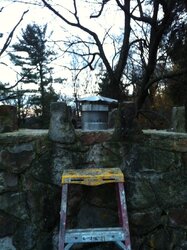
Put the cap on and done on top. This picture is a test fitting, I eventually got the cap on level.
Next I put in the block-off plate that I had built. Ended up installing it a little higher than the 2" above lintel that was suggested in the info article, but that's where it ended up seating, so I am ok with it. Used Fireblock silicone to seal the gaps. When I cut the hole, I knew that I needed a little extra room, so I drew a circle at 7 1/2" (knowing that the chimney liner was close to 7 5/8" around. Then I drilled holes on the exterior of the line using a 3/8" carbide drill bit. Then cutting on the outside of the drill holes with tin snips to cut out the round, I gave myself about 1/2-1 inch of wiggle room which ended up being perfect. The liner fit through snug enough that I didn't need to seal that hole. Plus with the Roxul above the block-off plate there's virtually no space for air to sneak through. The added benefit of this was that I still have some play in the liner for putting the stove in without directly pulling/pushing on the block off plate
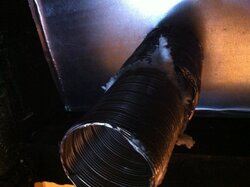
After that, I measured how high the stove was and cut the excess liner to height (again, angle-grinder was the way to go), and attached the stove connector. To make the cut, I wrapped a piece of duct-tape around the liner, then used a large rubber band to get a straight line that was the correct length (I think it was 27 3/4") Then I used a sharpy and traced a line around rubber band to give me a cut line on the liner. Took the band off, and made the cut. The other benefit of the duct-tape is it cuts down on the amount of sparks as you cut.
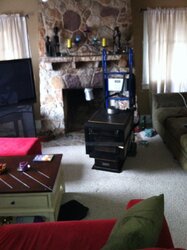
After that, it was just a matter of getting the stove in the fireplace and connected. I found the way to do this was to tilt the stove up at the front (which lowered the back end) and sliding it under the chimney liner, then when in place, setting it down, which very nicely set the connecter into the stove vent.
A little huffing and puffing here as I moved the stove to fit, but a couple of pieces of cardboard under the stove made it slide fairly smoothly into place, then I pulled the cardboard out as I set it level.
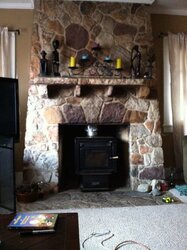
Thankfully my measurements were pretty close to spot on (measure twice (or 5 times), cut once), and the stove fit better than I had hoped!
Since it fit so well, I decided not to use stove screws to fix the connector to the chimney. My thought is since it fits tightly, and there is up-pressure from the stove, and down-pressure from the chimney, the screws weren't necessary, and poking holes in the liner (however well-filled by a screw) is just opening up points of weakness, and potential spots for hot-gas to leak out. Not sure if that's the right way of thinking, so I'll go with your advice on this.
After staring at my success for a while (and resting - hard work!), finally decided to get a test burn in. After re-reading precaud's link: h
ttp://www.hearth.com/talk/threads/kent-tile-fire-and-sherwood-stoves.60702/page-5#post-1578652
and the information article on the Kent Tile Fire, I felt brave enough to light a small fire. Fire lit well, and once the stove was hot, got a little smoke as the decades of dust burned off, and I got a little smoke from the insulation on the chimney liner. I'm assuming that was a little of the excess adhesive burning off. Only lasted for about 15 minutes, and haven't seen or smelled any since.
The next day, I build a real fire, and started to get acquainted with my new stove. Very impressed with how easily it runs, and most importantly (for my domestic well-being), virtually no smoke seepage.
Obviously being my first wood burner, I'm not qualified to make much in the way of comparison of quality, but this old Kent Tile is a cool stove, and has a pretty ingenious design. Once the fire is established, you close the damper which forces the exhaust up through a secondary burn chamber before it vent into the chimney. With the damper open there is not much heat transferred out (as all of the hot gas escapes directly into the chimney, but once the damper is closed, the stove heats up quite fast. Most of the heat seems to come out from the top, as the tile on the sides are relatively cool for about 30 min- 1 hour. This, however, is where my putting the block-off plate too high is coming back to get me. All of the heated air is going up the fireplace chimney to the block-off plate, then it spills out and goes straight up the ceiling.
Don't get me wrong, it heats the house, but the heat starts at the top and then gradually works it's way down, which is a bummer with 10' ceilings. I experimented a little with an oscillating fan (the only fan I have), blowing into the fireplace, and that is going to be the solution as it creates enough turbulence to blow the radiant heat out from the fireplace. The fan I have is too big, so I'm going to buy a small fan that I can put in front of the fireplace, and that should make everything better.
Other than that, I'm incredible impressed with the stove. I'm sure there are better, more efficient ones out there, but considering the circumstances, this is perfect, and I'm kind of geeky-proud to be running a relic like this.
----------------I've been capped on the number of pictures, so I'm going to post the rest in a new post-----------



 . So I made sure to keep it blocked off during the install.
. So I made sure to keep it blocked off during the install.



 Did the finish work with tin-snips.
Did the finish work with tin-snips.





